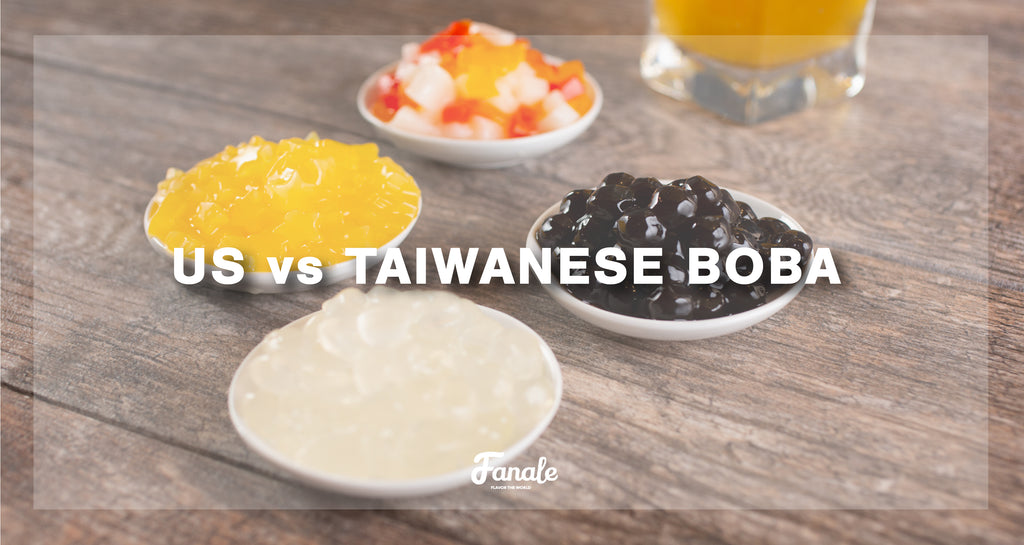US Boba vs. Taiwanese Boba

Bubble tea is not just a fad. The chewy, sweet, and delectable tapioca balls with milk tea originated in Taiwan, but the bubble tea market is projected to grow by over $4.3 billion in the US. The unprecedented success of the sweet treat has more to do with the higher quality production, manufacturing, and distribution methods that set boba made in the US far superior to its Taiwanese counterpart.
Why is US-Made Boba Superior to Taiwanese Counterparts?
Here are just some reasons why boba made in the US stands head and shoulders above Taiwanese brands:
Made Fresh Onsite
Tapioca pearls, aka boba, can lose their sponginess, take on an off-putting grey, yellow or green color, and lose shape. In Taiwan, most store owners make these at home in kitchens that do not have the same sanitation levels as US boba factories.
Boba imported from Taiwan takes three months to arrive in the US, by which time it is past or close to its 'best-by' date. The result is a flavorless or spoiled product that can make cafes lose customers leading to massive revenue loss.
US boba supplier and bubble tea manufacturer, Fanale, on the other hand, gets boba made in local factories with strict quality control standards that ensure the spongy and delectable mouth-feel for which this chewy and spongy treat is known.
Consistent Taste and Flavor
While boba was introduced to the US in the 90s by immigrating Taiwanese families, it really took off in cafés and coffee shops across the nation in the last decade. People couldn't get enough of the chewy and tasty topping and the Instagram-worthy pictures they could share.
But unlike their Taiwanese counterparts, which can differ in texture and flavor from one producer to another, US boba undergoes several quality control stages that ensure the taste, texture, and flavors fans have come to love.
Much of it has to do with the manufacturing steps used to make boba pearls. These include:
Mixing
Top-quality tapioca starch made from the cassava plant root is placed in an industrial mixer and mixed with potassium sorbate, brown sugar syrup, and guar gum. The result is a powder that is caramel in color and wet to the touch.
Beading
The powder is the base of the boba pearls. After mixing, it is moistened continuously with a light mist of water as it spins around and is scraped. The spinning and scraping shape the damp powder into round boba beads.
In a factory-controlled environment, workers have the equipment and training to ensure they don't add too much or too little water during the beading process. If the powder gets too wet, it clumps, but if it is too dry, the beads won't form.
Tumbling
Damage-free beads are tumbled in a separate machine with more water as a worker adds more tapioca starch. At this point, the beads grow in size into large pearls.
Sorting
When the pearls grow to a specific size (2.3 to 2.5 mm wide), they are deposited in a filter via a conveyor belt. Smaller beads are returned to the tumbler to grow in size first, and overly large ones are not discarded but broken down into powder to be assimilated in consequent batches.
Highly Sanitary Manufacturing Conditions
It should be noted that, unlike local Taiwanese boba, which is made by hand and is inconsistent in shape, size, and texture, boba made in US factories is mixed and shaped by machines from start to finish. That way, there is no contamination which can otherwise transfer diseases.
Uniform in Size and Texture
Boba has a texture that is as delicious as it is addictive, but it can be compromised if the pearls are not uniform in texture, taste, and size. Since Taiwanese boba is usually made in homes using DIY methods, they lack these qualities leading to inconsistent experiences.
On the other hand, boba, made in quality-controlled, US-based factories, has no such problem. As mentioned before, each pearl shares the same size, texture, and shape that fans have come to expect. That is why they turn into evenly tender, smooth, and spherical pearls when cooked well. They also have to be a specific size so they can be sucked up through a straw without getting stuck.
What is admirable is that many US-based boba producers and boba tea distributors, such as Fanale, are taking measures to reduce the size of the pearls so they can fit compostable straws. The aim is to reduce the use of single-use plastic straws, polluting our oceans and killing wildlife.
Enjoy Bubble Tea at Home with US Boba!
Boba is not a novelty. While it originated in Taiwan, it took off in US markets because of industry-strength quality control measures that ensured a larger market share. The popularity of the chewy tapioca pearls locally is unprecedented to the point that you can make boba at home and get the same size, texture, and taste you expect.
Do you want to make bubble tea at home without heading to the nearest café? Get a range of flavors from boba tea distributor, Fanale and have them at your doorstep in a few days. Use them as toppings for fruit tea, milk tea, coffee, Thai tea, shaved ice, ice cream, and more!
The quality of our inventory speaks for itself. With connections to international and national bubble tea manufacturers and boba tea distributors, we are always well-stocked with the best flavors. Get a variety of toppings for your milk tea and sweet treats, such as jellies, boba, popping boba, canned toppings, and even mochi.
- Frank Kuo









Comments 0